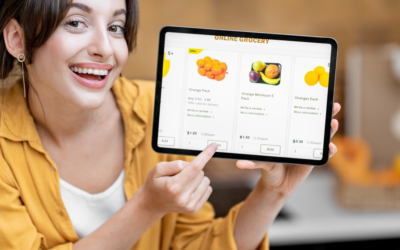Web Design Trends in 2024 Part 2
Your website is an important aspect of your marketing strategy — or it should be. Following the newest developments in web design is the most effective way to make sure your website stands out from the crowd as technology advances.
Web designers must always adapt to new opportunities and problems since web design and its best practices are dynamic. In 2024, advances in AI and a number of web design trends have changed the way that websites are made and used.
The best method to make an impression on your audience through your website is to provide them with current and popular content. You must simultaneously deliver a clear message and demonstrate to them what your brand is all about.
Website Design Trends for 2024:
An essential component of any website design is the user experience (UX) design. Your website design needs to be both aesthetically beautiful and useful if you intend on attracting visitors.
1. Scroll Triggered Animated Design:
Scroll-Triggered Animations are dynamic visual effects that come to life when visitors move around a website. By making browsing more dynamic and immersive, these interactive features increase user engagement. Content can be shown in an aesthetically appealing way, important information can be highlighted, and users can be guided through content by carefully timing animations to match scrolling.
Scroll-triggered animations provide an infinite amount of options for enhancing the depth and individuality of websites, ranging from modest transitions to intricate parallax effects. To prevent overloading consumers or impairing performance, it’s imperative to employ these animations carefully.
The effective integration of scroll-triggered animations necessitates striking a balance between usability and creativity. Animations should not detract from the content; rather, they should enhance the user experience and compliment the overall design. Designers can design compelling and memorable websites with careful consideration of time, pacing, and the overall user journey.
2. Depth and Dimension Design:
Dimension and Depth A popular trend that gives websites more visual appeal and realism in design. Designers can create an experience that is more immersive and engaging by integrating components that correspond to three dimensions. Websites can feel more dynamic and interactive by using techniques like parallax scrolling and layered content, which give them a sense of depth and dimension. It’s crucial to use these strategies carefully though, in order to prevent overloading users or degrading their experience as a whole.
3. Gradient Color Scheme:
Gradient color schemes provide a contemporary and eye-catching look. Gradients, which smoothly blend many hues together, can highlight items, provide depth, or just provide a visually pleasing background. They must be utilized carefully though, to prevent overwhelming users or degrading readability. Careful consideration of color combinations, contrast, and overall design coherence are necessary for successful implementation. Gradients, when applied carefully, can improve a website’s visual appeal and make the user experience unforgettable.
4. UX based Design:
The goal of user-centered design, or UX-Based Design, is to create services and products that are easy to use, efficient, and delightful. It includes studying user requirements, building visually appealing and functional interfaces, and performing research. From the first interaction to the end result, UX designers work to make the user experience smooth and delightful. By prioritizing user needs and conducting thorough testing, UX-based design ensures that products meet expectations and are easy to navigate.
5. Abstract Shapes Design:
Abstract Shape Design is a style that uses geometric shapes, lines, and patterns that do not immediately resemble real-world objects. These abstract features can give websites a new and visually appealing dimension while breaking away from typical design conventions. Abstract shapes can represent abstract ideas, evoke strong visual compositions, or express feelings. To keep the overall design coherent and intelligible, it’s crucial to use them carefully and in concert with other design aspects.
In order for implementation to be successful, creativity and clarity must coexist in togetherness. Using the shapes in a way that improves the user experience and coordinates with the overall design is recommended. A website can be made visually striking and memorable that stands out from the crowd by designers carefully examining the meaning and impact of abstract shapes.
6. Modern Minimalism:
A popular design style that prioritizes simplicity, straight lines, and negative space is modern minimalism. Minimalist designs produce a look that is clear and uncluttered, aesthetically pleasing, and easy to navigate by removing unnecessary features. This strategy works especially well for websites with a lot of information or little screen real estate. But it’s crucial to make sure the minimalist style doesn’t ruin from the design’s ability to be interesting and educational. A careful balance between efficiency and simplicity is necessary for successful implementation, making sure the design is neither unduly basic nor devoid of visual appeal.
7. Rotating or Sliding Animation Design:
Rotating or Sliding Animation Using dynamic visual effects in design is a trend that aims to direct attention and improve user engagement. Designers can make a webpage more dynamic and visually appealing by carefully rotating or sliding items. These animations can be utilized to highlight important information, uncover hidden material, or just give the design a little more dynamism. It’s crucial to use these animations carefully, though, to prevent overwhelming users or making navigating more difficult.
Careful consideration of timing, pacing, and the overall user experience are necessary for a successful implementation. Rather than taking away from the content, the animations should be used to promote navigation and complement it. Designers can create engaging and memorable websites by carefully applying these animations.
8. Embedded Videos Design:
A popular trend in online design is embedding videos directly into web pages, or embedded video design. Videos are an excellent way to tell stories, present information, or highlight goods and services, making for a more captivating and immersive user experience. When using embedded videos, it’s crucial to take accessibility, loading times, and video quality into account.
To prevent interfering with the user experience, videos should be placed strategically on the website and optimized for web viewing. Moreover, subtitles and transcripts can increase accessibility and accommodate individuals with hearing difficulties. Effective use of integrated movies allows web designers to produce more interesting and educational websites that make an impact.
9. Detailed Footers Design:
A popular approach that concentrates on producing educational and eye-catching website footers is called Detailed Footer Design. Footers can be a useful tool for users by including pertinent links, contact details, social media buttons, and other helpful components. Careful consideration of visual hierarchy, information structure, and overall design aesthetics are necessary for successful deployment. Clear labels and links should be present in well-organized, user-friendly footers.
It’s also crucial to refrain from packing the footer with too much information, as this can make it challenging to understand and utilize. Websites can offer a more comprehensive and user-friendly experience by creating visually beautiful and useful footers.
10. Responsive Web Design:
A website that uses responsive web design can automatically adjust to various screen sizes and devices, offering a consistent and best-in-class user experience on all platforms. Websites can automatically adapt their content and layout to meet the precise dimensions of the device being used by using media queries, responsive images, and flexible layouts. This guarantees that consumers, whether using a desktop computer, tablet, or smartphone, can quickly find and engage with websites.
A careful balance between functionality and aesthetics is necessary for the successful implementation of flexible web design. The design should look polished and aesthetically pleasing while remaining user-friendly and simple to use across all platforms. Websites with a focus on responsive design can reach a larger audience and deliver a more engaging user experience.
Wrapping It Up:
To be modern and creative, designers must continue to be flexible. Designers can push creative boundaries by being aware of and using evolving trends, which helps their work stand out in a crowded market and connect with modern audiences.
In 2024, web design will have evolved to the point where designers are encouraged to try new things, embrace diversity, and push the envelope. Designers can create websites that not only fulfill practical requirements but also motivate consumers by remaining inquisitive and receptive to emerging trends.





